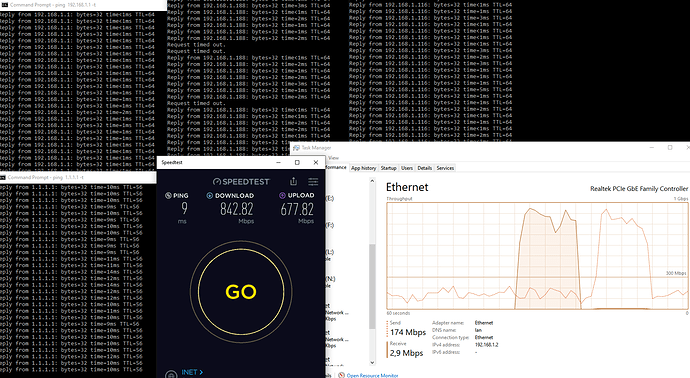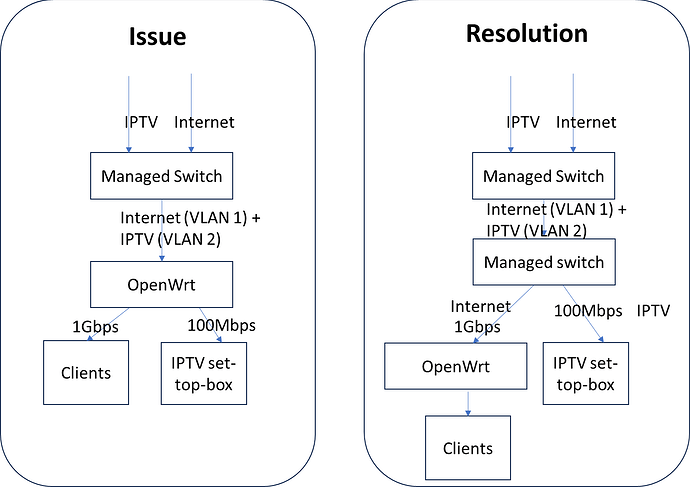I checked @ACwifidude repo. It doesn't include SSDK. My own personal builds do include the SSDK utility.
With the help of @quarky I managed to turn off Flow Control of the R7800 switch.
Unfortunately it just helped with WAN speed but at the expense of LAN traffic disruption
So in this situation it is a chose only one option situation - WAN or LAN. Both are not possible at the same time.
That will not allow what I can achieve with ISP router, but it has a terrible WLAN an of course has nothing that OpenWrt gives me.
It is interesting that there are similar performance issues on the Mikrotik forum when using mixed 100Mbps and 1Gbps devices. First one is here https://forum.mikrotik.com/viewtopic.php?t=185253
I've even considered possibly to get a Mikrotik RB5009UG+S+IN as it has a 10G SFP+ cage port but there is similar WAN performance issue although the users complain when they mix 2.5G and 1G devices.
https://forum.mikrotik.com/viewtopic.php?p=920760#p895221
So spending a sum of money to only see the same issue with 100Mbps devices maybe is not so good choice.
I guess your options are:
- get gbps-capable end devices
- get a better switch with per port queues (might help)
- try to fudge something with cheap gigabit switches isolating each of the 100 Mbps end devices
- try to rate limit the 100 Mbps devices so that they never trigger the pause frame generation.
Any other options?
P.S.: Have you tried just disabling pause frame processing on the server?
- I cannot do anything about it - TV manufacturer put 100Mbps NIC and other devices are from ISP for the TV service (they have 100Mbps NICs too).
2, 3 and 4 - I don't think I'll bother with them. I'm looking for one device solution for neat environment.
I've tried here. Same result as in my previous post - WAN traffic at full speed at the expense of LAN traffic disruption.
The only thing that I don't understand is how another manufacturer (I talk about the ISP router) can resolve the same situation and what they used to overcome the issue I face when mixed devices are connected to the switch. It's strange that big and famous manufacturers cannot resolve this. And as we all see there are still a lot of Fast Ethernet devices around.
I guess there are more options, since you know the IP addresses of the problematic machines, you could implement traffic shapers on the server that make sure these three? hosts will only ever be serviced at 94Mbps or so, which if set correctly should avoid tickling the switch to generate pause frames. (The problem is that pause frames operate per link, not per flow/connection/destination, so to avoid running into this issue you need to make sure you do not trigger the issue).
Add a multiport NIC to the server and connect each of the offending devices directly with one NIC port.
Today I had some spare time and devoted it to testing this further for almost three hours.
You can see here that when Flow Control was disabled on the R7800 built-in switch I couldn't get uninterrupted LAN traffic.
In the next tests I've used R7800 with default switch settings (Flow Control is Enabled).
This time I decided to disable the Flow Control of the PC NIC (Realtek) as I posted here.
As you can see from the post I didn't get the uninterrupted LAN traffic with Belkin RT3200.
For my latest tests I've used R7800 but I've disabled Flow Control of the PC Realtek NIC. As @moeller0 suggested
To my surprise this time I was able to get full WAN speed on the PC while it was streaming the same 4K movie stream (I've used for the previous tests) simultaneously to three 100Mbps devices (two 4K AndroidTV boxes and a 4K Smart TV) connected to second gigabit switch and one Laptop, connected as a 100Mbps device to the R7800 built-in switch, which was running iperf3 session to the PC server.
This way I had four simultaneous LAN transfers all from the PC to four different 100Mbps devices. All LAN traffic was going almost completely uninterrupted. I had only 4 or 5 single occasional ping losses to the 100Mbps devices for more than 30 minutes while I was running numerous (more than 50) WAN speed tests on the PC at full WAN speed. I didn't observe any LAN traffic interruption during this long test session.
With this setup I can say that my task is 99% possible.
I doubt that I can surely say the issue is completely resolved only because there are different hardware combinations that still cannot complete the goal of uninterrupted WAN/LAN traffic at full duplex speeds.
Any other thoughts from anyone here on the subject?
Reading this Hamlet's question https://blogs.cisco.com/perspectives/to-flow-or-not-to-flow
and this one http://rjapproves.com/netapp-vs-vmware-flow-control-dilemma/
I knew at least that Flow Control when enabled/disabled can give different results depending on the specific configuration and use case.
The question remains that for some routers as R7800 there is no way to disable the Flow Control of the built-in switch and more importantly are there other ways to workaround this situation.
LAN traffic will necessarily be interrupted since the speedtest or movie server is throwing data toward the 100 Mb device at 1 Gb. The switch's options when that happens is to either flow-control the source or drop most of the packets that are arriving faster than they can be sent out.
The general principle of the Internet is in case of a bottleneck somewhere along the way, packets will be dropped. There's nothing else to do with them. There are more sophisticated schemes (not found in consumer-grade switches) to also notify the source that specific packets are being dropped, and it should please slow down sending on that connection.
DCTCP with CE-marking switches perhaps?
Any form of ECN will work, no need for DCTCP! Aggh, @moeller0...
Didn't know there are switches with rfc3168 marking behaviour.
WRED is commonly available on mid-to-enterprise grade switches. The brick wall RED configuration for DCTCP I have no idea if anyone uses, and while we've been disparaging about RED, it does work somewhat.
I want to say here that a working workaround for me is to disable Flow Control of the Desktop PC server gigabit NIC. At least when using R7800.
This is for the people that experience the same performance degradation as in my case.
Hi @sppmaster I had exactly the same issue. Finally resolved it (or worked around it actually) and I want to share my experiences.
In my case I had to put 2 data streams into one wire using VLAN trunking. One was normal internet connection, second was IPTV data stream to a 100MBps set-top box.
Problem and resolution are depicted on the image below.
Before solving it, I tried all possible ways, various devices running OpenWrt, various configurations, stock firmware routers, to no avail. The only router that somehow managed to give stable TV stream with no frame drops was Linksys EA6900 running stock (OpenWrt not supported due to incompatible Wifi chip), however internet speed was decreasing a lot when TV was on.
I have finally resolved the issue using simple 20$ Zyxel managed switch - GS-1200-5. I am very happy, getting Gbit speeds on the Internet and no frame drops on TV. It seems that most routers and OpenWrt have a bug that is not blocking common use / this use case is quite rare.
I wanted to share my final setup that works around the issue because it may be helpful for others.
Probably stupid question, why did it not work to simply use the first managed switch to split of the IPTV to its set top box?
I would think that there is only one Ethernet cable available between two places in the house, thus it is necessary to trunk Internet and TV on the same cable between two locations.
There are no stupid questions, I believe many others would have it. I should've highlighted that in my first comment.
Indeed, as @mk24 correctly suspects, there is only one UTP cable laid in the wall between the place where GPON is and the room with set-top box & wired clients.
In fact, back when setting it up for the first time, I was trying to minimize amount of hardware needed and had only one switch, with MAC based VLAN and set top box MAC address added to the TV VLAN. Linksys EA6900 was doing switching & providing internet access then, this was functioning, but far from perfect (no frame drops on TV but decreased internet speed when TV was on). I tried replacing this EA6900 with Asus, MikroTik, stock, OpenWRT, DD-WRT and it was always worse than with EA6900. Finally found the setup with cheap Zyxel managed switch (it's capabilities are impressive, especially given its low cost and max power consumption of ~2.5W).

